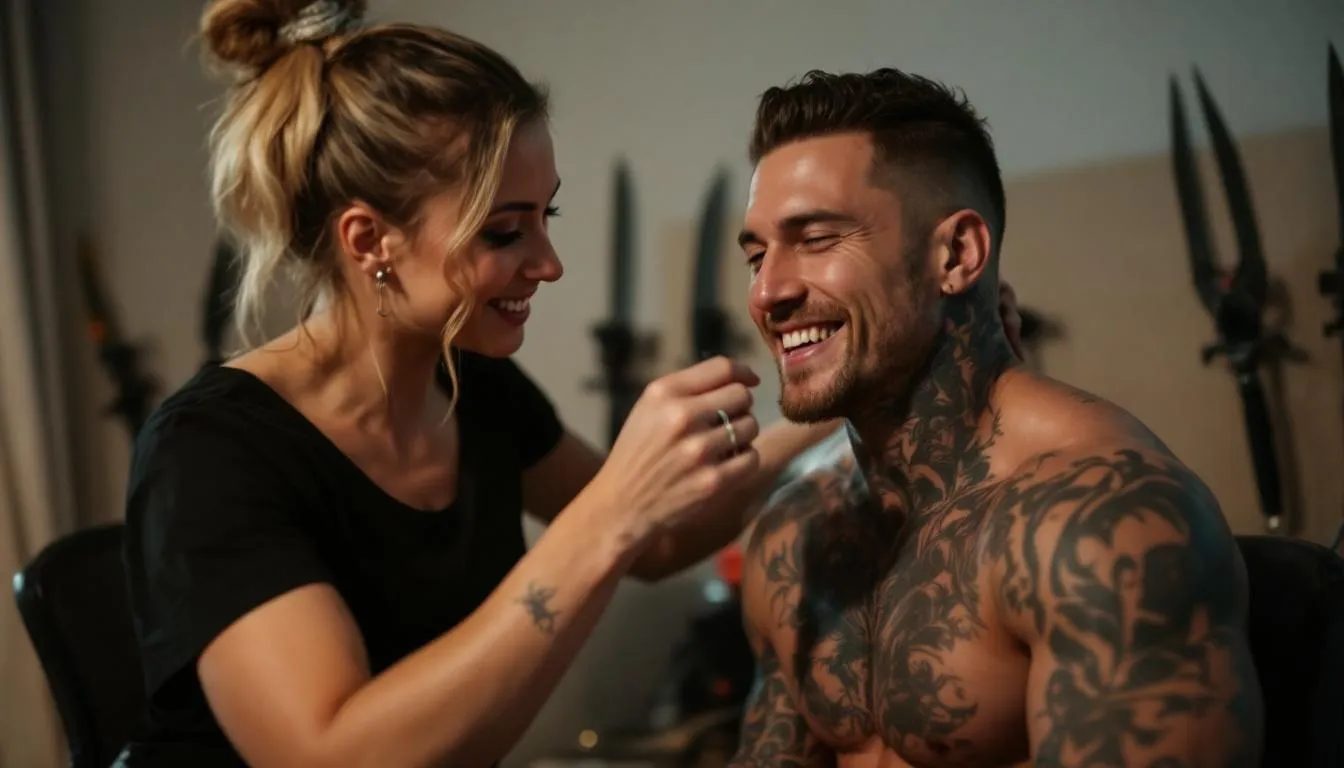Curious about how dominant’s relationships explained dominant and submissive dynamics in daily life play out? In this article, we explain what dominant’s relationships are and how these dynamics extend beyond the bedroom into everyday routines. You’ll learn how consensual power exchanges affect decision-making, interactions, and overall relationships, helping you understand this unique bond.
Key Takeaways
- Dominant and submissive relationships rely on consensual power exchanges, strong communication, and mutual respect in both intimate and everyday contexts.
- Various D/s dynamics like master/servant, caregiver/little, and 24/7 can enrich relationships by providing structure, emotional connection, and fulfilling experiences.
- Key elements of healthy D/s relationships include ongoing boundary negotiation, aftercare to reinforce trust, and active participation in the BDSM community for support and resources.
What is a dominant and submissive relationship?

A dominant and submissive relationship, often referred to as a D/s relationship, revolves around a consensual power exchange between partners. In these dynamics, one partner, known as the dominant, maintains control while the other, known as the submissive, willingly follows. The submissive partner often feels empowered by surrendering control in a D/s relationship, as this act is rooted in trust and mutual respect. This power play isn’t confined to sexual encounters; it extends into various aspects of daily life, creating a unique bond built on trust and mutual respect. Additionally, the D/s dynamic can foster personal growth, as dominant partners may set goals for submissive partners, encouraging them to develop and achieve new milestones. It is important to define the different types of D/s roles, as each couple may define their dynamic differently based on their needs and preferences.
At the heart of a D/s relationship is clear communication. Both partners must articulate their needs, desires, and boundaries to ensure that the power exchange remains consensual and respectful. This communication is crucial for maintaining the emotional well-being of both the dominant and the submissive. Doms, or dominant partners, play a crucial role in maintaining communication and safety within these relationships. The roles can be fluid and adaptable, allowing for various forms, including long-term exclusive relationships, polyamorous setups, or even casual encounters.
In these dynamics, the dominant partner controls, while the submissive partner consensually gives up control. This exchange is always rooted in mutual consent and understanding, forming the foundation of a healthy and fulfilling D/s bondage relationship where partners decide together. Sexual relationships within D/s dynamics often involve erotic power exchanges and mutual gratification.
Whether the dominant people are a man, a dominant woman, or non-binary dominant person, and whether the submissive is a masochist or not, the principle remains the same: a consensual and respectful power exchange that does not matter. People engage in D/s relationships in a variety of ways, from casual play to committed partnerships.
How do dominant and submissive dynamics manifest in daily life?
Dominant and submissive dynamics can weave seamlessly into the fabric of daily life, influencing everything from decision-making to social interactions. Dominant partners often take charge in various aspects, such as planning activities or making important decisions, like buying a house or planning a vacation, while submissive partners play a supportive role, creating a collaborative and harmonious environment. Defining roles in D/s dynamics can lead to fewer arguments over decision-making, as both partners have a clear understanding of their responsibilities. This balance of power fosters teamwork and enhances communication, as both partners work towards common goals.
These dynamics can also manifest in more subtle ways. For instance, dominant partners might use non-verbal cues that only their submissive partners recognize, adding a layer of intimacy and understanding to their interactions. Public behavior in D/s relationships is often adjusted to maintain discretion, while private behavior may express the dynamic more openly. This can be as simple as a glance or a specific gesture that conveys a message known only to them. Dom acts, such as giving instructions or providing guidance, can also reinforce the power exchange in everyday situations, helping to maintain the dynamic outside of explicit scenes. Such cues help maintain the power exchange without drawing unnecessary attention in social settings.
The roles in a D/s relationship are flexible. Both dominant and submissive partners can adjust their behavior based on the context and setting. Everyday behaviors, such as who leads discussions or makes plans, can reflect dominant and submissive tendencies. Successfully integrating these dynamics outside the bedroom requires intentional emotional engagement and a deep understanding of each other’s needs.
Types of dominant and submissive dynamics

Dominant and submissive dynamics come in various forms, each offering a unique way to experience power exchange. These dynamics can extend beyond sexual contexts, influencing daily activities such as social outings or even grocery shopping. BDSM practice can involve a continuum of experiences, ranging from light bondage to more intense scenes and specialized activities. Some couples engage in occasional scenes, focusing on power-based role plays that add excitement and variety to their relationships.
Common types of dominant and submissive relationships include master/servant, caregiver/little, and 24/7 dynamics. Another example is the pet owner/pet dynamic, where the Dom takes on the role of a pet-owner and the submissive is the pet, often explored through pet play. Each type has its own set of expectations and practices, allowing couples to choose the dynamic that best suits their preferences and lifestyles.
These dynamics can provide structure and enhance the emotional connection between partners, making the power exchange and power dynamics a deeply fulfilling experience of sex and sexual pleasure. Some D/s relationships also incorporate a training regimen, where the dominant guides the submissive through structured routines to develop new skills or behaviors.
Master/servant
In a master/servant dynamic, the submissive person primarily serves the dominant partner in various tasks. This can range from laying out clothes and helping the dominant get ready to more specific acts such as caring for boots and leathers. The submissive may provide not only sexual service but also perform domestic tasks for the dominant. The focus is on service and obedience, with the submissive person dedicating themselves to fulfilling the needs and desires of the dominant. Training relationships often involve the dominant partner acting as a teacher, guiding the submissive in developing specific skills or behaviors, further enriching the dynamic.
This dynamic often involves a clear set of expectations and routines, providing both partners with a sense of purpose and fulfillment. The submissive’s acts of service are a way to demonstrate their desire, devotion, and commitment, while the dominant takes on the responsibility of guiding and caring for their submissive in specific roles.
This mutual exchange of power and care can strengthen the bond between partners and create a deeply satisfying relationship with the other partner.
Caregiver/little
The caregiver/little dynamic is characterized by one partner taking on a nurturing role, while the other assumes a more child-like role. The submissive may take on age roles ranging from a baby to a young child or even an adolescent. This dynamic allows the submissive to release anxieties and be cared for by their dominant partner, providing significant emotional benefits.
Activities in this dynamic can include nurturing and caretaking scenes, as well as elements of discipline and punishment, such as spanking. A caretaking scene is a specific type of interaction where the dominant provides nurturing care to the submissive, emphasizing emotional support over discipline. The caregiver/little dynamic creates a safe space for the submissive to express vulnerability and for the dominant to provide support and guidance. This act fosters trust and connection between the participants.
This mutual consensual exchange fosters a deep emotional connection and a sense of security for both partners, based on mutual agreement.
24/7
A 24/7 dynamic involves the dominant partner maintaining control over the submissive at all times, impacting various aspects of their daily lives. This continuous power exchange requires a high level of commitment and communication, as both partners must be on the same page regarding their roles and expectations.
The 24/7 dynamic can create a profound sense of connection and trust, as the power exchange becomes a big difference and integral part of their everyday lives in the world, shaped by their own experiences, and they realize this connection.
Safety precautions in dominant and submissive relationships
When engaging in dominant and submissive relationships, prioritizing safety is essential for ensuring a positive and fulfilling experience for everyone involved. Whether you’re a dominant partner or a submissive person, establishing healthy boundaries and maintaining open communication are the foundation of a safe and respectful dynamic. Before any scene or role play, it’s important for both partners to discuss their desires, limits, and expectations, making sure everyone is on the same page.
One of the most important things in any dom sub relationship is the use of safe words or a key word. This allows the submissive partner to immediately pause or stop the scene if they feel uncomfortable or need a break. Safe words empower the submissive person to communicate their boundaries clearly, and it’s the responsibility of the dominant partner to respect and respond to them without hesitation.
In specific scenarios like chastity play, where a cock cage or chastity belt might be used, the dominant person must ensure that the submissive partner’s emotional well-being and physical safety are always prioritized. Training relationships and caretaking scenes should also be approached with care, with both partners agreeing on the terms and boundaries before engaging. This level of preparation helps prevent misunderstandings and ensures that the consensual exchange of power remains healthy and enjoyable.
Seeking guidance from a sex therapist or kink instructor can be invaluable, especially for those new to BDSM or exploring new dynamics. These professionals can offer advice on how to navigate power exchange, set healthy boundaries, and maintain emotional well-being throughout your relationship.
The BDSM community places a strong emphasis on mutual respect and understanding. People involved in dominant and submissive relationships are encouraged to communicate openly about their needs, concerns, and boundaries. This culture of respect helps foster trust and ensures that everyone feels safe and valued.
Negotiating boundaries and maintaining healthy dynamics

Setting and respecting the sub’s boundaries is essential for maintaining healthy and fulfilling dominant and submissive relationships. Negotiating the sub’s boundaries ensures mutual comfort and safety, allowing both partners to engage in the power exchange with confidence and trust. The submissive partner retains the ability to stop any scene or relationship at any time, ensuring that their autonomy and well-being are always prioritized. Participants in BDSM should create a checklist of what they are comfortable with and what is off-limits to ensure clear communication. The important thing is that a safe word is crucial in these dynamics, providing a unique and easily recognizable signal to immediately pause or stop during role play if necessary. The key word here is communication.
Negotiating boundaries should be an ongoing process, with consent being revisited regularly to adapt to the evolving needs of both partners. Open communication about feelings and boundaries is crucial for maintaining emotional well-being in a dom/sub dynamic. This continuous dialogue helps ensure that both partners feel heard and respected, fostering a healthy and supportive relationship, as advised by a clinical sexologist.
Maintaining healthy dynamics also involves understanding and respecting each other’s limits. In some dom/sub relationships, the submissive may intentionally test limits or behave provocatively to receive punishments as part of a consensual power exchange. Ignoring established boundaries can lead to feelings of resentment, discomfort, and mistrust. By prioritizing communication and mutual respect, couples can navigate their dom/sub dynamics in a way that enhances their connection and emotional well-being.
The role of aftercare in daily dom/sub dynamics
Aftercare is a vital component of dom/sub dynamics, facilitating emotional recovery and enhancing trust between partners. It refers to the connection time between the dominant and submissive after a scene, where they can process their experiences and provide reassurance to each other. This time is essential for both partners, as it helps them transition back to their everyday roles and emotions.
Activities in aftercare can include:
- cuddling
- drinking water
- discussing the scene
- providing emotional support
Both dominants and submissives may experience strong post-scene emotions, so aftercare helps them reconnect and reinforce their bond.
By prioritizing aftercare, couples can ensure that their dom/sub dynamics remain healthy and emotionally satisfying.
The benefits of dominant and submissive dynamics

Engaging in dominant and submissive relationships offers numerous benefits, from building trust to enhancing emotional and sexual satisfaction. One of the key advantages is the deep level of trust that develops between partners, as open discussions about preferences and boundaries foster a stronger connection. This trust can lead to fewer conflicts and a more harmonious relationship.
Participating in D/s dynamics can offer several benefits:
- Reduced anxiety levels associated with engaging in BDSM practices.
- Enriched sexual experiences, leading to higher levels of satisfaction compared to conventional sexual practices.
- Decreased likelihood of infidelity by fulfilling both emotional and sexual needs.
- Sensory play can deepen intimacy and provide unique, pleasurable experiences for both partners.
Connecting with the BDSM community provides valuable support and resources for those exploring dom/sub dynamics. Engaging with like-minded individuals can offer guidance, education, and a sense of belonging, making the journey of exploring these dynamics more fulfilling and enjoyable.
Common myths about dominant and submissive relationships

There are many common myths and misconceptions about dominant and submissive relationships that can create misunderstandings and stigma. Most people who participate in D/s relationships do so in a safe, consensual, and respectful manner, contrary to common myths. One such common myth is that all submissives are masochists and all dominants are sadists, which is not universally true. These dynamics are diverse, and individuals may have varying preferences and needs.
Another misconception is that D/s relationships are inherently abusive, with one partner controlling the other’s friendships and life choices. In reality, healthy dom/sub relationships are built on mutual consent and respect, and any form of abuse is not acceptable. Negative media portrayals often associate BDSM with violence and criminality, further perpetuating these myths.
Understanding the diversity and complexity of dom/sub relationships is crucial for dispelling these misconceptions. By recognizing that these dynamics are consensual and rooted in mutual respect, we can appreciate the unique ways they enhance the lives of those involved.
Tips for integrating dom/sub dynamics into daily life
Integrating dom/sub dynamics into daily life requires understanding different styles, effective communication, and utilizing available resources. Knowing the various dom-sub styles and their requirements is the first step in creating a fulfilling dynamic. In some dynamics, such as chastity play, the dominant partner decides when the submissive is allowed certain privileges, reinforcing the power exchange. Books like “The New Topping Book” and “The Ultimate Guide to Kink” can provide valuable insights and guidance for couples looking to explore BDSM practices.
Communication is essential for managing dynamics in a dom/sub relationship. By discussing needs, desires, and boundaries openly, couples can ensure that their power exchange remains consensual and respectful. Communication in a D/s dynamic is often structured to allow submissives to voice concerns while generally following directions. Regular check-ins and honest conversations help maintain a healthy and satisfying dynamic.
Establish clear communication
Establishing clear communication is fundamental in dominant and submissive relationships. Engaging in erotic communication, even through texts, can enhance the bond between partners. Effective communication allows both partners to articulate their needs and desires, ensuring that the power exchange is consensual and fulfilling.
Mutual respect and agreement are crucial for maintaining a healthy dom/sub dynamic. By talking openly and defining their roles and boundaries, couples can create a deeper understanding and connection. Clear communication helps prevent misunderstandings and ensures that both partners feel valued and heard. Additionally, it is important to talk about feelings and needs to foster a supportive environment.
Set and respect boundaries
Setting and respecting sub’s boundaries is vital for the safety and trust in a dom/sub relationship. Clear boundaries ensure that both partners feel safe and respected. Effective communication of boundaries involves open dialogue and the use of safe words to signal when something needs to stop.
By respecting each other’s healthy boundaries, couples can foster trust and emotional well-being in their relationship. Ignoring established boundaries can lead to resentment and discomfort, so it’s important to prioritize mutual respect and responsibility.
Join the BDSM community
Joining the BDSM community can be incredibly beneficial for those exploring dominant and submissive dynamics. Connecting with like-minded individuals provides a support system, resources, and guidance, helping you navigate your dom/sub relationship with confidence. If you don’t have a partner yet, the community can also be a place to find potential partners who share your interests and values.
Engaging with the BDSM community offers numerous educational resources, such as workshops and a kink instructor, to help you understand the intricacies of these dynamics. Whether you’re interested in chastity play, role play, or other aspects of BDSM, the community can provide valuable insights and support.
By immersing yourself in this supportive environment, you can enhance your understanding and practice of dom/sub dynamics.
Summary
Dominant and submissive relationships offer a unique and enriching way to connect with your partner. From understanding the fundamental principles of consensual power exchange to integrating these dynamics into daily life, the journey requires clear communication, mutual respect, and a commitment to ongoing negotiation and aftercare. By exploring the various types of dom/sub dynamics, such as master/servant, caregiver/little, and 24/7, you can find the structure that best suits your relationship.
The benefits of engaging in these dynamics are numerous, including building trust, reducing conflicts, enriching sexual experiences, and enhancing emotional well-being. By dispelling common myths and misconceptions, we can appreciate the diversity and depth of dom/sub relationships. As you continue to explore and integrate these dynamics into your life, remember to prioritize communication, boundaries, and connection. Embrace the journey and enjoy the profound intimacy and fulfillment that dominant and submissive relationships can offer.
Frequently Asked Questions
What is a dominant and submissive relationship?
A dominant and submissive relationship is all about a consensual power exchange where one partner takes control while the other submits, built on mutual respect and clear communication. It can enhance intimacy and trust between partners, going beyond just the physical aspects.
How can dominant and submissive dynamics be integrated into daily life?
You can easily weave dominant and submissive dynamics into your daily life through thoughtful decision-making and even in simple, everyday interactions. Just remember, clear communication and emotional engagement are key to making it work smoothly!
What are some common types of dominant and submissive dynamics?
You’ll often find master/servant, caregiver/little, and 24/7 dynamics among dominant and submissive relationships. Each type really brings its own flair to power exchange, creating unique roles and expectations for those involved.
Why is aftercare important in dom/sub relationships?
Aftercare is vital in dom/sub relationships because it fosters emotional recovery and strengthens trust after a scene. Taking time to reconnect—through cuddling, hydration, and open discussions—helps both partners process their experiences together.
What are some common myths about dominant and submissive relationships?
It’s a myth that all submissives are masochists or that all dominants are sadists; healthy D/s relationships thrive on mutual consent and respect, not abuse. Remember, understanding these dynamics is key to fostering a positive experience for everyone involved.



























Leave a Response
How can we help?
Still have questions?
Ask your question below and we'll show you the most relevant answers.
Browse by Category
community
Do I need an account to purchase albums?
Yes, speakmydesires needs you to have an account for album purchases, which will have great deals and discounts!